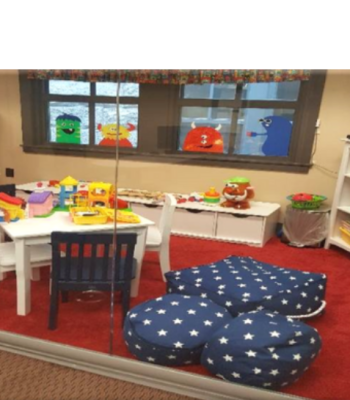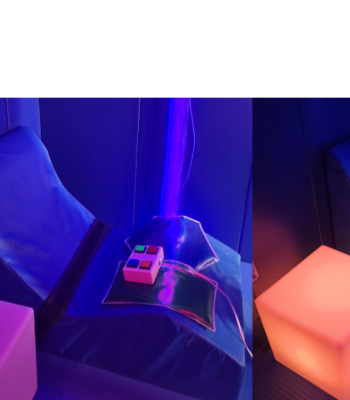Autism Connection of PA Board of Directors Meeting
A Progression of Sensory-Friendly Performances in Pittsburgh, PA
Sensory-Friendly performances have become a relatively new tradition for many families in the Pittsburgh area. The venues offer a “relaxed” atmosphere that is calm and welcoming. The accessible performances emerged in 2013, and have continued to create lifelong memories for people with autism or sensory processing disorders ever since, and the Pittsburgh CLO has adopted the tradition with its sensory-friendly A Musical Christmas Carol.
Autism Connection spoke with Vanessa Braun from the Pittsburgh Cultural Trust and Lindsey Kaine from the Pittsburgh Ballet Theatre to learn the history of sensory-friendly performances in the Steel City, beginning with two groundbreaking features: The Lion King and The Nutcracker.
Autism Connection: How did the wonderful opportunity to bring sensory-friendly performances to Pittsburgh present itself?
Vanessa Braun: I first learned that the Theater Development Fund in New York City was making Broadway shows accessible to an audience on the spectrum through a piece on the national news. I went to work the next day and brought it up in a conversation with our Director and Assistant Director of Guest Services, telling them that this was happening in New York, and did they think that we could make a similar show happen in Pittsburgh. They then told me that The Lion King would be returning to Pittsburgh in 2013, and that they loved the idea and agreed with me that we were completely capable of bringing an autism-friendly or sensory friendly show to the Pittsburgh market.
“We started a trend and Pittsburgh, our region, has actually become a national leader in autism-friendly and sensory-friendly programming, which we’re pretty proud of and it’s impressive for a small city like ours.” -Vanessa Braun
Autism Connection: What did your research entail?
Vanessa Braun: Three representatives from the Cultural Trust traveled to the Kennedy Center’s (LEAD) conference and attended a session about their work conceiving of and executing their two shows with Disney, The Lion King, and Mary Poppins. We also met with the Theater Development team at the conference. They invited us to New York to see their second Lion King show in action.
After our fact-finding trip, we really got into the fine details of making this show happen. We secured the date with the tour, and it was to be the third week of a four-week run. It was vital for us to choose a Saturday to appeal to as many families as possible. We also stayed connected with our friends at the Ballet. Their first show would take place in December of 2013, and we worked together on some outreach, and of course, took the lead on training our front of house staff who would later work their show.
“Our sensory-friendly performances are a step toward making the excitement and beauty of a ballet performance barrier-free, accessible and welcoming to everyone in our Pittsburgh community.” Pittsburgh Ballet Theatre
Autism Connection: What kind of organizational commitment did each of your organizations invest in these shows?
Vanessa Braun and Lindsey Kaine: For us it was first financial, even with a group discount on the entire house, we wrote Disney a 200,000 check to buy out every seat. Why, may you ask, do we buy out the house? It is because we recognize that Broadway is an expensive endeavor. If you are coming to a typical show, you are paying $60-150 or more per ticket. Top tickets for Hamilton were going for $450 per ticket. We know that that is prohibitive for a family, and we know that parents of children on the spectrum, or who have other academic or sensory needs.
Autism Connection: Did you hold special trainings for staff and volunteers? Did you bring in outside experts?
Vanessa and Lindsey: Every volunteer and front of house staff member was specially selected to work our first show. Even with our high criteria we brought in our friend and expert, Lu Randall Executive Director of the Autism Connection to train our team. Everyone who was in the theater that day was trained by Lu. Over the past ten years she has continued to train our staff and volunteer core and she and her team have been invaluable to us.
Another group of people who we work with is the group of actors who are on stage. We like them to know a bit about our audience and differences that they may experience in timing or audience reaction. We explain that some laughs or applause breaks may differ from the typical show that they do night after night. We always get a great response from these cast meetings.
- Vanessa Braun, Director of Accessibility and Manager of Employee Engagement at the Pittsburgh Cultural Trust
- Lindsey Kaine, Manager of Accessibility & Program Development at the Pittsburgh Ballet Theatre
Autism Connection: For readers who may not have been to your performances, can you describe the differences and similarities to a typical performance that an audience member may see at one of your shows?
Vanessa and Lindsey: First, we have a team of outside professional volunteers, doctors, teachers, nurses, people who know the audience and who can help if needed. We spread them out throughout the venue. Then in the lobby we set up at least one quiet space and one activity space. In these areas, people can either stop in to blow off some steam or alternatively come to have a moment of calm.
In the theater itself, we have the lights up to about a quarter of their regular brightness, this is so that people can feel free to get up and down if they need to throughout the show. We have ushers and theater staff to hand out fidgets and share needed information. We allow personal snacks and communications devices that you would not see at a typical show.
Other than that, we want the experience to be regular with some supports, but regular. Production–what people see on the stage–is controlled by the touring show, but a few elements are softened or removed. So, the show takes out a bright flash of light or a sudden noise. The important thing is that the show stays true to itself.

Audience enjoying a sensory-friendly performance
Autism Connection: What do you have in mind for the future?
Vanessa Braun: In 2015 we started offering one sensory friendly show each year at the Children’s Theater Festival. We will continue that practice and keep an eye on the Broadway touring schedule. We look for shows out there that have broad based appeal, a show that will attract at least 2,000 community members, and a show that will be with us for three weeks or more. We love to bring Broadway to this new audience and are excited for the chance to do it again.
Virtual Workshop: Presuming Capability, Raising Expectations
This is a free workshop, but registration is required. Register Here
Family Division of the Allegheny County Courthouse Initiates Sensory-Friendly Areas
Autism Connection of Pennsylvania is thrilled to announce sensory-friendly areas in development at the Family Division of the Allegheny County Courthouse. We explored the facility with The Honorable Jennifer McCrady, the judge who initiated the project, who also took time to answer our questions about the importance of sensory-sensitive spaces.

Judge Jennifer McCrady stands in the Sensory Room in the Allegheny County Family Division Courthouse
Autism Connection: What prompted you to create the sensory-friendly areas?
Judge McCrady: The Family Division is a chaotic environment and can be very overwhelming for members of the community to navigate. The majority of the individuals entering the building have experienced a trauma and may have any number of disabilities. We, as a court, needed to do better to recognize that the physical space was not conducive to the population that we serve. After input from stakeholders, youth, and families, the court partnered with Carnegie Mellon Human Centered Design class to revamp the space and communication. As part of the recommendations from CMU, it was clear that the court needed to make improvements for individuals with disabilities. The sensory room provides a quiet and calm space for an individual in a rather chaotic environment.
Using Physical Space to Create a Sense of Wellbeing
Autism Connection: Is physical space important to a person’s sense of wellbeing?
Judge McCrady: Yes, physical space is very important to a person’s wellbeing. The need for a calm, quiet, and safe space may be critical to helping the individual to successfully navigate the process. As a court and through the many improvements implemented, we are striving to be transparent, promote trustworthiness, and provide the public with a sense of empowerment as they navigate a stressful and hectic environment.

Photo of sensory room in the Family Division of the Allegheny County Courthouse
Autism Connection: What is the first step others can take in creating similar environments?
Judge McCrady: Start small by providing fidget toys to youth, improve signage in the facility, train system players and frontline court employees on how to interact with members of the public in a trauma-informed way. The first encounter with a court employee can set the tone for the rest of the experience. Build toward creating sensory spaces and sensory areas. Improve docket management systems so there is less downtime as well as reasonable expectations for waiting time. Provide quiet and cleaning waiting spaces with access to vending machines and wi-fi service.
![]()
Safe Family Resource Center and Wellness Clinic

Safe Family Resource Center: Confidential areas for victims of abuse. Self-contained, private, play space for children and youth with separate waiting and check-in areas for plaintiffs and defendants

Wellness Clinic:
Easy access in the Children’s Room staffed by Children’s Hospital professionals, and available for all children waiting for a hearing
Creating the Conditions for Sensory-Friendly, Trauma-Informed Spaces
Judge McCrady anticipates factors that can add to stress when visiting the courthouse. The project addresses these issues by creating safe spaces, using technology, and clear signage throughout the building. Visitors know where they need to be, and when. Details like charging stations Wi-Fi access can alleviate common concerns. The sensory room serves as a retreat where visitors have control of their surroundings.

Comfortable seating with light and sound control
- Sensory-Friendly fidget toys available in every courtroom with many refills accessible by contacting Judge McCrady’s staff
- Outdoor retreat
- Outdoor playground
Autism Connection: Do you see this work becoming standard practice?
Judge McCrady: We found that there are many foundations and funders who are interested in this type of project and willing to help offset costs. If not for the many foundations that we worked with, we would not have been able to accomplish this project. Our hope is that court systems recognize the impact that trauma can have on an individual, and how important it is for our public court spaces to provide the appropriate and necessary trauma-informed accommodations for those with disabilities. It is an attainable goal.
Introduction to Autism
Getting any new diagnosis comes with the need to understand it. Learn the basics about autism, and get some take-home tips, from people who understand and have worked in this field for 20+ years.
We will explain the details about autism and how brain differences help shape personality, likes, dislikes, fears, eating, sleeping, the senses, and communication. Please come and ask your questions, meet others with similar concerns and learn what to do at home and in the community!
This is a free workshop, but registration is required.
Behavioral Health Commission Special Report 2022
We are powered by an amazing board of trustees who actively engage in the work we need to in order to be a lifeline for families and adults, which is our mission. One of our unsung heroes is the Hon. William F. Ward (Bill) who serves on the Pennsylvania Commission on Crime and Delinquency (PCCD). As PCCD’s representative, Bill was key in creating funding opportunities in this Behavioral Health Commission Special Report. Follow the link below to read the full report.
Behavioral-Health-Commission-Report
Act 54 Areas of Focus (page 3)
- Delivery of services using telemedicine
- Behavioral health rates, network adequacy, and mental health payment parity
- Workforce development and retention
- Expansion of certified peer support specialist services and peer-run services
- Development and provision of crisis services
- Integration of behavioral health and substance use disorder treatment
- Cultural competencies when providing behavioral health care
- Impact of social determinants of health on behavioral health
- Intersection of behavioral health and the criminal justice system
- Establishment of an integrated care model that can deliver timely psychiatric care in a primary care setting
On page 7, the Commission recommends that we “develop and expand upon pre-arrest diversion programs that connect people with resources in a time of crisis, including individuals with intellectual disabilities and with autism spectrum disorder.”
Bill Ward took a few moments to answer some clarifying questions about the recommendations:

Bill Ward, Past Chair, Autism Connection of PA Board of Trustees
Autism Connection: What does “pre-arrest” actually mean?
Bill Ward: There are two different types of arrests. There is a custodial arrest, which is when a person is detained, is not free to leave the scene, placed in handcuffs, and removed to the local police department. (There are also non-custodial arrests, such as when a person is given a citation or ticket for a summary offense but is allowed to leave the scene without being processed at the local police department.) The concept of “pre-arrest” is focused upon those encounters or incidents where the police have the discretion to not detain and charge a person, but instead would “divert” them from being criminally charged. In my mind, “pre-arrest” is too narrow a restriction. More often, the police will detain and charge a person. Even so, much good work can be done to divert the offender after the arrest but prior to the Preliminary Hearing, usually set for 10 days later.
Autism Connection: Can you give us a brief description of the co-responder model? Is there a good resource for this model?
Bill Ward: One definition is: “A model for crisis response that pairs trained police officers with mental health professionals to respond to incidents involving individuals experiencing behavioral health crises.” Here’s a link to an article discussing the co-responder model:
Responding to Individuals in Behavioral Health Crisis Via Co-Responder Models
The BHC Report recommends that $5 million be dedicated to counties to develop or expand co-responder models, and to train first responders in crisis intervention.
Autism Connection: Anything you’d like to add?
Bill Ward: Yes. While $23.5 million is recommended to improve the criminal justice and public safety systems, $5 million (of the $23.5 million) will be to develop and expand upon pre-arrest diversion programs that connect people with resources in a time of crisis. The Behavioral Health Commission was receptive to put in that such funding expressly include “individuals with Intellectual Disabilities and with Autism Spectrum Disorder.”
Autism Connection of Pennsylvania recognizes the tireless dedication our Board of Trustees demonstrates. When you see something that speaks to your need, know that our awesome board has had their fingerprints on that – for our literal minded readers, this means they have inspired, worked on, or supported that activity in a meaningful way.











